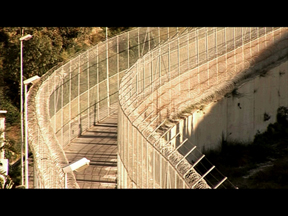Program 4: Migrant and Diasporic Histories II
Date: Tuesday, April 19, 2011
Time: 6:00 p.m.
Location: Center for Art, Design and Visual Culture, UMBC
DIRECTIONS & CAMPUS MAP
Cost: Free

Capsular
Herman Asselberghs
2006, DVD, 23 minutes, Belgium
This video, by Belgian artist Herman Asselberghs, investigates the divide between Europe and Africa, North and South, “inside” and “outside,” through the particular site of Ceuta, an autonomous Spanish enclave nestled on the North African side of the Strait of Gibraltar. Investigating the geopolitical, as well as the philosophical implications of having a fenced off enclave of the European Union situated on the African continent, the work considers ways in which this isolated space negotiates necessary African involvement in Europe’s questionable immigration policies, and the implications of outsourcing the border of Europe, both physically and symbolically, to a different continent.
Eurolines Catering or Homesick Cuisine
Pavel Braila
2006, DVD, 17 minutes, Moldovia/Germany
Playfully uncovering the connections between food and homesickness as central to the migratory experience, this engaging piece presents the trajectory of a bag of home-cooked Moldavian dishes prepared by the artist’s family across Europe, from Braila’s hometown in Moldavia to a Berlin art gallery opening. Employing the low-budget bus line Eurolines for sending the food, the package traces the itinerary of many Eastern European immigrants going west in order to find work.

My America
Egle Rakauskaite
2003, DVD, 12 minutes, Lithuania
Traveling to America to visit her relatives, the artist takes up a job often assigned to newly arrived immigrants: taking care of the elderly and the physically or mentally challenged. The video shows her carefully fulfilling different aspects of her job, while different soundscapes and a voiceover provide an impressionistic evocation of her experiences in America as an immigrant. Through different levels of representation, the piece comments in diverging ways on those left out or left behind in popular and mainstream depictions of America as a migrant’s destination.
Crossing Over
Tanja Ostojic
2001, DVD, 7 minutes, Serbia/Germany
In 2000, artist Tanja Ostojic started the “Looking for a Husband with EU Passport” project. Publishing an ad with this title, she exchanged over 500 letters with numerous applicants. Following correspondence with a German man for over six months, their first meeting was arranged and recorded as a public performance in front of the Museum of Contemporary Art in Belgrade in 2001. The video documents this meeting, with subtitles providing a subjective framing for the event. In her work, Ostojic uses her own identity and body to forcefully comment on immigration policies, bypassing the abstract notion of “the migrant” to evoke a personal, individualized and gendered experience.

Green Dolphin
Oliver Husain
2008, DVD, 15 minutes, Canada
In Green Dolphin, German-Indian artist and filmmaker Oliver Husain constructs a hybrid narrative in which reality and dream worlds converge, constructing seemingly coherent spatiotemporal unity between disparate locales, from Kuala Lumpur to Toronto. Inspired by the 1947 film Green Dolphin which starred Lana Turner, this playful short piece presents a Filipino Canadian dancer as she relates her intricate love affairs to us, her character mediating between different diasporic universes.

eight to four
Usha Seejarim
2001, DVD, 8 minutes, South Africa
Usha Seejarim, a South African artist of Indian heritage, investigates the multiplicity of histories and questions of memory at work in specific, everyday geographies of South Africa. In this work, she presents visual recordings of the roads of the country, which were formed as a result of forced migration. eight to four captures the shadows of vehicles passing along highway M1 South, a route connecting Johannesburg to Lenasia, a township which was specifically demarcated for South Africa’s Indian population during apartheid.
Encore (Paradise Omeros: Redux)
Issac Julien
2003, DVD, 5 minutes, UK
This short film, a reworking of Julien’s earlier multi-channel video piece Paradise Omeros (2002) follows Nobel Prize winning Caribbean poet Derek Walcott to Santa Lucia, a place of origin for Julien as well, as his parents migrated from the island to England in the 1960s. The film, inspired by Walcott’s epic poem Omeros (1990), evokes experiences of displacement and alienation, as striking, luscious, color-saturated imagery and Walcott’s voice-over associated with the homeland are staged against London’s drab, industrial wasteland.
